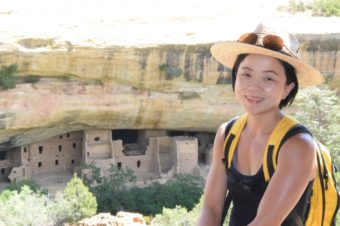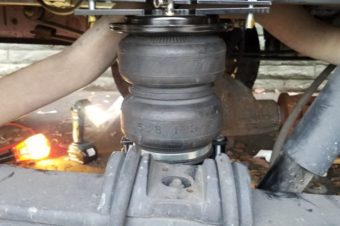The Día de los Muertos (Day of the Dead) holiday is a fantastic time to experience the beautiful and charming town of colonial San Miguel de Allende. In this article, I share with you all you need to know about experiencing Día de los Muertos in San Miguel de Allende like a local.
When I first researched Día de los Muertos in San Miguel, I found a lot about fancy rooftop parties and expensive package deals attended mostly by partygoer gringos.
That’s totally cool, if you’re into that… but I wanted to find the “authentic” celebration of Día de los Muertos.
I’ll walk you through how you can find the free community events where you can experience Día de los Muertos like a local. Be in the know before you get to San Miguel de Allende, because there is a lot to discover and experience!
DangGoodLife Note: As a travel planner, I love detail. I do in-depth travel research because it’s fun, it gives me context, and it helps me filter for new information while I’m traveling. This article has a lot of detail for travel planners and information-absorbers like me. That’s why it’s such a long article! Feel free to use the table of contents to jump to the parts that interest you.
Table of Contents
Why Día de los Muertos in San Miguel de Allende?
For the past two years, San Miguel de Allende has been named the best city in the world by Travel+Leisure magazine.
Even if you’re not the Travel+Leisure type, the honor of this title must pique your curiosity, if just a little. I mean, why would this small city in the highlands of Mexico outrank so many other cities in the world?
Is it the nearly perfect year-round weather, the well-preserved baroque and neo-classical architecture, or the city’s reputation as a center for artists and expats from around the world?
Or, is it the picturesque homes with shades of orange, red, and pink, bordered by narrow cobblestone streets, or the relaxed atmosphere of a small, friendly Mexican city that continually gains a melting pot of expats from all around the world?
Here’s why you should experience San Miguel de Allende during Día de los Muertos:
- Día de los Muertos decorates an already beautiful city into the most charming fairy-tale destination that is quintessentially Mexican in tradition and appearance.
- Día de los Muertos in San Miguel is an intimate and underrated experience. This is especially true compared to Mexico City or Oaxaca, cities that have heavily marketed their Day of the Dead activities.
- The weather is wonderful at this time. The days are warm, but not hot. There’s no humidity. The nights are cool but not yet chilly.
- The streets are the liveliest during the three-day festival of Día de los Muertos, from October 31 to November 2. It’s a great time to visit for the most to see and do, in this otherwise quiet destination.

Travel Basics: Getting to San Miguel de Allende
At square one, you want to book your arrival into San Miguel.
Perhaps one of the biggest deterrents to visiting San Miguel is the extra commute time required to get here, since this semi-remote city doesn’t have an airport. What it lacks in direct flights though, it makes up for in bus routes.
There are three airports to choose from:
- The nearest airport is in Querétaro (QRO), a 75-minute drive from San Miguel. This is a straight and easy highway, and seems to be preferred. There are buses from the Queretaro bus station, but most visitors take pay-per-person shuttles.
- The next airport is just outside of León, the Aeropuerto Internacional del Bajío (BJX). The drive takes 90 minutes. There’s no bus for this route yet, but pay-per-person shuttles are available.
- The last option is Juarez International Airport (MEX) in Mexico City. The drive is about 3.5 hours. Buses to San Miguel leave from Mexico City Norte (the North Station).
I mention driving times as guidelines for distance, but I do not recommend driving in San Miguel during the holiday (more on this below). Instead, I recommend taking the bus, shuttle, or taxi/Uber. They’ll likely get you there faster than the hassle of renting a car. Many companies provide these services, and they are very foreign-tourist-friendly.
If you want to minimize your spending and maximize your time in San Miguel, you may want to run a couple of sample scenarios. The “best option” also depends on how many people are in your party and which airlines service your route. Examples:
- If you want to fly to QRO or BJX, you will likely be transferring from MEX. You may save some time and money by skipping the transfer flight and catching a bus from Mexico City instead. Don’t worry – a 3.5-hour bus ride sounds worse than it really is. It’s a comfortable, modern and dare-I-say luxurious ride. Be sure to select the directo route.
- Consider getting a taxi, Uber, or private shuttle if you have a party of two or more. Depending on how many are in your party, you may end up saving money or spend just a bit more for a more friendly, personal experience.
- If you’re arriving late at night, you may want to get a private car anyway, to avoid being stranded somewhere if you make a mistake. Driving at night is not recommended for several reasons (roaming livestock, truck drivers, hidden speedbumps, etc.).
Bust out an excel spreadsheet – it’s all part of the planning process!
Once you decide what you want, remember to book your transportation in advance if it’s possible. Día de los Muertos is a very busy time for San Miguel. Buses and shuttles will book up, so plan ahead or you may be stuck waiting.
Travel Basics: Where to Stay in San Miguel de Allende
Next, you want to book your accommodations.
In this section, I lay out several facts to help you decide where to stay in San Miguel de Allende. (Spoiler alert: it’s not a big deal! Phew!)
I end with a description of each neighborhood, and an RV park, if you’re overlanding through Mexico.
Fact #1: San Miguel is small and walkable enough that you do not have to nitpick about where to stay.
Everything in the blue circle below is within a roughly 15-minute walk to the city center. Pick something inside of this circle – regardless of whether it’s a hotel, Airbnb, B&B or vacation villa – and you’ll be close enough to everything.

Walking is the most recommended form of transportation. The compact, pedestrian-friendly centro historico (city center) of San Miguel is best experienced on your feet. You can wander through hidden courtyards, crowds of people, and expansive plazas at your ease. You can follow your eyes, nose, and ears without having to overthink it.
The fun of Día de los Muertos happens in the streets, around the sizzle of street-side taco carts, and in the many community squares set up with the hustle and bustle of vendors, beautifully-dressed Catrinas and Catrins, and larger-than-life mojigangas posing for pictures.
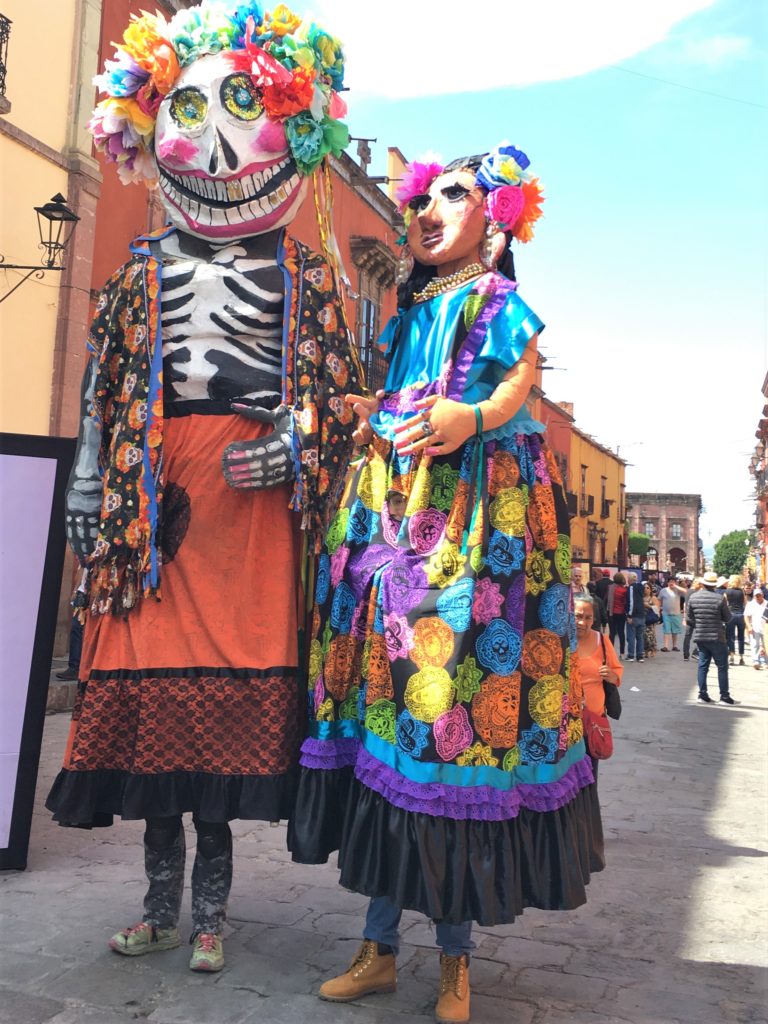

Fact #2: Taxis and Uber are available and easy to use, but during Día de los Muertos, traffic congestion is rough.
It is possible to stay farther from the centro and take a bus, taxi or Uber into town. But it will require some patience.
Traffic in San Miguel is rough during holidays and weekends, when cars are often sitting ducks sandwiched among streams of fast-moving pedestrians.
If waiting in traffic doesn’t sound fun, I recommend choosing more central accommodations.


Fact #3: Día de los Muertos festivities are expected to change every year.
You might be thinking: “I’m going to choose the best location to stay based on the Día de los Muertos festivities.”
That’s a very nice, strategic thought, and exactly what I would do.
However, based on my research, the word on the street, and our experience in 2019, it sounds like San Miguel now intends to change the location of Día de los Muertos events every year. And, it also seems like the exact where-and-when doesn’t get released until about a week before.
I know, that doesn’t make it easy for planning. In 2019, events were centered around the barrio (neighborhood) of San Juan. In 2018, it was spread out between the jardín in front of the Parroquía and several plazas nearby.
While this annual ‘mixing it up’ will undoubtedly add a bit of confusion to the planning process, it’s all good! Remember Fact #1 – San Miguel is small and walkable enough that you do not have to nitpick about where to stay. Walking and wandering are part of the adventure.
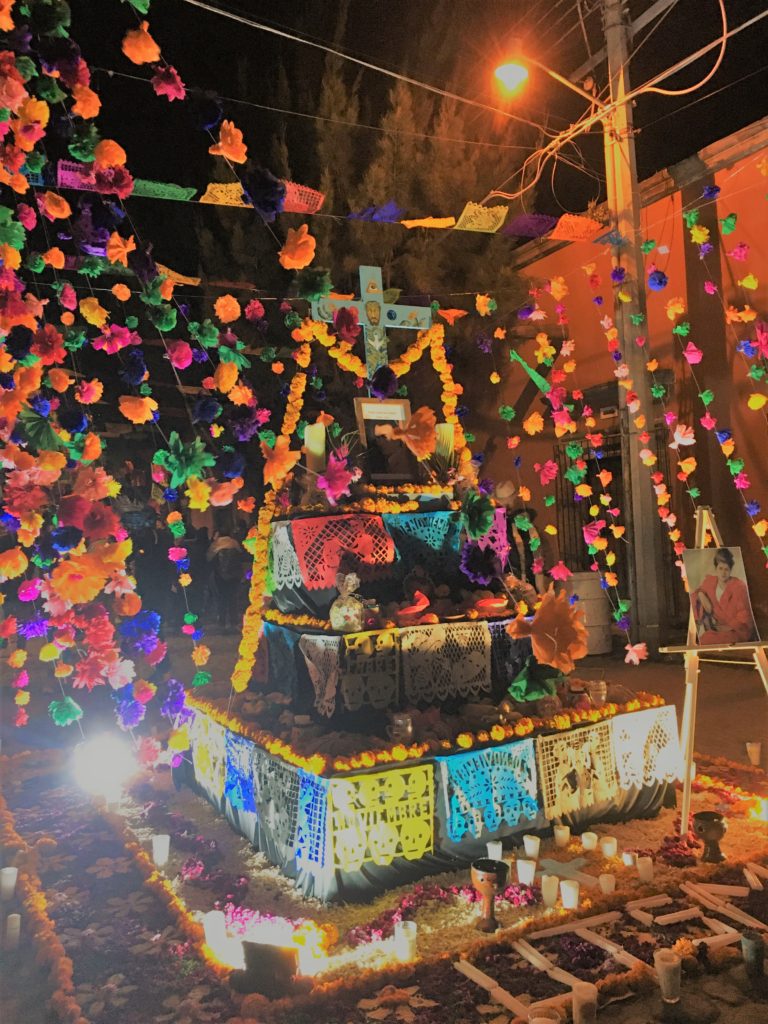

Fact #4: The local colonias (neighborhoods} of San Miguel are diverse and offer different experiences.
Let’s get back to the blue circle.
If you’d like to stay close enough to walk everywhere, the best neighborhoods to consider are the Centro, San Rafael, Guadalupe, San Antonio, La Guadiana, or El (Juárez) Parque.
The Centro is where most tourists will spend most of their time. To the west of the Centro is San Rafael, a friendly Mexican neighborhood where I stayed. To the north of the Centro is Guadalupe, recently famed for its graffiti murals. San Antonio, to the south, is a mix of Mexican and expat, with lots of charm and less overtly touristic traffic. Lastly, La Guadiana and El Parque neighborhoods are a seamless blend of upscale residences and tourist accommodations, with art galleries, restaurants, and the leafy Juarez Park.
Stay in the Centro for:
- The most central access to the busiest tourist areas: La Parroquía (the town church – not cathedral, as is often said), El Centro Cultural Ignacio Ramírez El Nigromante (the former convent-turned-cultural-center), and Plaza Civica (the Civic Plaza).
- Feels like: a lively and ever-entertaining center of activity, or an over-cultivated tourist zone, depending on your perspective. You are in the middle of it all!
- Visit: for most of the tourist sites, boutique shopping, restaurants with a view, lively bars, and street food.
- Reconsider: if you get overwhelmed, claustrophobic, or annoyed with heavily trafficked, loud, or touristic places. You’ll frequently hear the church and watchtower bells ringing, fireworks going off, and music from all corners.
Stay in San Rafael for:
- A “daily life” Mexican neighborhood, with the large San Juan de Dios market, a church, a primary school, and a couple of playgrounds. We stayed a week here – you can read about our experience staying in San Rafael
- Feels like: a close-knit neighborhood of friendly Mexican families, complete with guard dogs on the roof, clucking chickens, and tiny cobblestone alleys on hilly streets.
- Visit: for a day amongst the locals, shopping at a traditional mercado (a market of groceries, clothing, and wares) and fast-casual budget dining, compared to the touristic centro.
- Reconsider: if you’re out of your comfort zone in a primarily Spanish-speaking neighborhood with a more “local” experience. San Rafael has had a bad rap in the past, but we had no problems staying here for a week, walking home at all times of the night.
Stay in Guadalupe for:
- A colorful mural-filled villa that is very accessible to the centro, with a mix of local resident and tourist scenes.
- Feels like: a mix of Mexican and expat residents with artistic overtones.
- Visit: for a very photogenic stroll through amazing murals from local artists.
- Reconsider if: over-cultivated art tourism irks you (Okay, I’m reaching a bit for this, but some find the fabricated feel of Fábrica la Aurora is a bit overwhelming)
Stay in San Antonio for:
- A mixed neighborhood of Mexicans and expats, with a church and plaza, art galleries, restaurants, and higher-end markets and bakeries.
- Feels like: a quiet Mexican neighborhood with a hipster expat twist
- Visit: for a healthy, hipster, artsy day picking up baked goods and groceries, doing yoga, shopping for crafts, and stumbling upon art galleries.
- Reconsider if: you want something marginally closer to the city center, as the only way in is through Ancha de San Antonio
Stay in La Guadiana and El Parque for:
- Equal parts wealthy resident (Mexican and expat) and tourist (mid- to upper-range hotels), with access to San Miguel’s favorite leafy green park, Parque de Juarez. These elegant neighborhoods are north of Ancha de San Antonio, one of the city’s major in-and-out thoroughfares with great restaurants and shopping.
- Feels like: upscale touristy and elegance, as fancy as San Miguel can get. Very few locals.
- Visit: for a stroll through Juarez Park, dinner at some of the best restaurants in San Miguel, and wandering several food and craft markets
- Reconsider if: you want a more budget-friendly place or something farther from the tourist path.
Our Experience Living in San Rafael:
For a week, we stayed at a fantastic Airbnb deep in the neighborhood of San Rafael.
Living amongst the local Mexican residents, with very little tourist traffic, was an absolute pleasure. It’s a place where people still greet each other upon passing, where children take over the streets when school lets out. It’s a place for everyday commerce: groceries, carnicerías (butcher shops), pop-up vendors, and fast food (a-la grab-and-go, not Big Mac). I hate to use the “A” word, but it certainly felt much more authentic to live here than in the tourist zone.
The tourist zones are still close enough though. A walk to the Parroquía took us less than 15 minutes, most easily via Calle de Canal or Calle de Insurgentes. Or, we cut through colonia (neighborhood) San Antonio to access the other major tourist area, the busy street of Ancha de San Antonio (which becomes Zacateros or Salida a Celaya, depending on the direction you’re heading).
We were also lucky because the Day of the Dead festivities for 2019 just happened to be centered around barrio San Juan, which was right down the street from our Airbnb. Every time we passed by, we could see the progress of setup, display, and, eventually, take-down.
I highly recommend staying in San Rafael and would do it again in a heartbeat!
Fact #5: There IS an RV park in the middle of San Miguel!
Some of you may know DangGoodLife.com as a site about VanLife, so I would be remiss if I didn’t mention anything about vanlife in San Miguel. If you’re not an overlander, skip this section.
Out of nine nights in San Miguel de Allende, we spent two of them at San Miguel’s only central RV park. We spent the other seven nights at an Airbnb, to get a sense of living in a typical home in a typical Mexican neighborhood.
The RV park is in the neighborhood of San Antonio, a great location. It is just off Ancha de San Antonio, about 5 minutes from Parque Juarez. It has full hookup sites with water, electric, and sewer, clean restrooms, hot showers, and good wi-fi.
The owners are very cautious about dogs, for the safety of their tennis patrons. Yes, the RV park is also a tennis club, and quite a popular one at that.
I highly recommend this RV park. It was a great place to meet other overland travelers.


Travel Basics: Safety in San Miguel de Allende
Safety in Mexico is one of the highest searched phrases when it comes to traveling to Mexico.
I get it: if you’ve been told by family, friends, neighbors, and strangers on the street, “I read that these two people were killed…” over and over, you might be a little nervous, skeptical, or even downright scared.
So, is it safe to visit San Miguel de Allende? In a word, yes.
No one cannot guarantee that you and your belongings will be 100% incident-free in San Miguel de Allende, but let’s keep a few things in mind:
- Traveling in Mexico is like traveling in any other destination in the world: one must practice common sense. It doesn’t matter where you are; you should still lock your doors, keep your wallet tucked securely away, and avoid getting too drunk. Being safe as a traveler boils down to building safe travel habits.
- Mexico is a massive country with many states, just like the U.S. If cartel violence is happening in Sinaloa, that is so far from San Miguel de Allende, it’s like saying “Be careful in Oregon because Walter White killed someone in New Mexico.”
- Drug-related crimes are targeted. Stay out of the game and you will not be targeted.
- Everyone should do their current events research when they’re traveling to a new place, wherever it is. Just please take it with a grain of salt – violence happens around the world. Some media will sensationalize and others won’t have the full story, making some violence appear randomized. For every news article you find about violence in any city in Mexico, think about how many you’ve heard about in your very own hometown.
- Some specific tourist spots have a higher risk of petty theft, the more crowded or touristy it gets. Get travel gear that reduces the chance of theft. Follow your gut when judging people, places, or situations. Be nice but not naïve.
For our experience traveling to San Miguel in late 2019, we were aware of cartel violence far away in other parts of the country. These parts of the country we specifically avoided in our driving routes.
We were also aware of some incidences in San Miguel. These acts of violence – also apparently cartel-related – specifically targeted wealthy Mexican locals. The expats we spoke to conveyed that Mexican-to-Mexican crimes are far more common than those that involve travelers or expatriates. With this contextual information, we felt very safe traveling in San Miguel.
Practice safe travel habits and enjoy your time in San Miguel de Allende!
Travel Basics: Getting Around San Miguel de Allende
Walking Shoes
I wish I could provide you a statistic, like “X% of injuries at the hospital are tourists’ sprained ankles.” I don’t have that information, so instead I’ll do a short public service announcement.
This is not a place for uncomfortable high-heels. I’m not saying that you won’t find them worn by a handful of determined ladies, but do you really want to limit your exploration of this beautiful place because you can’t walk?
- Sidewalks vary from one corner to the next, and sometimes even more frequently. They vary from beautifully paved to flat cobblestones to rounded rocks (read: slippery). They can be two abreast, just one foot across, or none at all.
- Sidewalks dip frequently to create narrow driveways, or they elevate suddenly into stairs and ramps. Tired feet are careless feet.
- The hills are alive with… pedestrians and cars in San Miguel. Dodging all these things simultaneously requires a little bit more of your attention— and your balance.
- Lastly, consider the damage to your beloved shoes. Even if you last the night injury-free, your shoes may not.
I’m very short, at 5’0, so I understand wanting to look and feel taller. If you must, I recommend thick-heeled boots or wedges.
Taxi vs. Uber:
Taxis are everywhere in San Miguel. They are so easy to flag down and get going. Uber is available, but it usually requires a wait since there aren’t that many on the road.
Pro for Taxis:
- Easier to find, with no wait.
- No searching for the correct vehicle, if there’s a busy crowd.
- When getting in a taxi, always ask the price first before the ride starts. To prevent getting the “gringo price,” ask the price not as “Cuanto cuesta” (how much) but as a confirmation of the price you think, i.e. “Cincuenta, verdad?” ($50, correct?). In late 2019, the going rate was $50-$60 pesos, plus tip. When you go, ask around for the normal rate.
Pro for Uber:
- You get the car license plate, the driver’s name and ride history, and a way to contact him in case you leave something behind.
- You get the Uber rate, which can be $1-3 less than the taxi rate.
- You can type in the exact drop off location, without having to explain it verbally. This is especially useful if it’s an obscure destination.
- It’s a non-cash transaction, which I really like. Just remember to tip (I leave the tip through Uber).
Driving:
I do not recommend driving in the colonial center of San Miguel. The streets are narrow and hilly, there’s very little parking available where you want it, and the roads are often congested.
To be clear, I’m not saying that driving in the centro is difficult; it just seems that the hassle of driving and parking in San Miguel is never worth any benefit earned from having your own wheels.
If you plan to drive into the city, from the airport or elsewhere, I recommend you park the car in a paid estacionamiento (parking lot) and leave it be.
Google Maps:
Google is, of course, the go-to source of information. But sometimes, you have to finagle it a bit to find what you’re looking for in Mexico.
- In Google search, it’s a trial-and-error practice. I finally found the schedule of events when I searched “Día de los Muertos [the year] Calendario.” Other search terms, like schedule, eventos, or itinerario, didn’t produce the results I needed.
- In GoogleMaps, you may have to try searching just some of the words. For example, “barrio de San Juan de Dios” on the calendar doesn’t show up on GoogleMaps. “San Juan de Dios” does. This tripped up a fellow traveler who unfortunately missed the events because he couldn’t find the location on GoogleMaps!
- In GoogleMaps, some of the locations are in English and some are in Spanish. Some are mislabeled, or only come up if you look up a specific term (panteón vs. cemeterio).
- In GoogleMaps, it’s good practice to visually check the accuracy of the pin. For example, the pinned location for San Miguel’s Plaza de los Insurgentes was erroneously put at a four-way intersection that didn’t look like it had a plaza. I eventually found where the plaza was really located, about a mile away, and submitted the correction. Another hint is when there are only a couple reviews for something that should have hundreds of reviews – it’s probably someone’s silly mistake. So, a quick doublechecking can save you a lot of time.
- Sometimes, GoogleMaps is just plain wrong. The days, the specific location, the hours, the basic existence. Even road directions aren’t always right. Get used to it. I always caveat to my husband, “Well, at least that’s what GoogleMaps says.” ¯\_(ツ)_/¯
An Introduction: San Miguel de Allende for Día de los Muertos (Day of the Dead)
For the past two years, San Miguel de Allende has been named the best city in the world by Travel+Leisure magazine.
And, Día de los Muertos is one of Mexico’s most uniquely decorated and colorful holidays.
So, said another way:
You’re going to be visiting San Miguel de Allende, “the best city in the world,” during Día de los Muertos, one of the most beautiful Mexican holidays of the year!
Saying it out loud makes it more real, doesn’t it? I hope you’re excited, because I’m excited to share with you my recommendations for:
- Getting to know San Miguel de Allende: the people, the sights, the history.
- Experiencing the three-day holiday of Día de los Muertos as it’s celebrated in San Miguel.
I’ve created a map with everything that I mention in this article.
Part I: Getting to Know San Miguel de Allende
A Very Brief History of San Miguel de Allende
The name “San Miguel de Allende” is made up of two different people: Juan de San Miguel and Ignacio Allende.
Juan de San Miguel was a Franciscan friar. In 1542, he built a Franciscan mission about 5km from what is today San Miguel. The land belonged to the indigenous Chichimeca Confederation, who did not take kindly to the colonization or the Spanish treatment of the enslaved indigenous people. A new site was found just a mile east, with two fresh-water springs, and the town of San Miguel was re-established in 1555.
Ignacio Allende is today recognized as a hero of Mexican Independence. He was a Spanish military officer when he came to sympathize with the idea of Mexico’s independence from Spain. Allende, along with Juan Aldama, Miguel Hidalgo, and Josefa Ortiz de Domínguez, conspired against Spain by assembling an insurgent army, entering San Miguel, naming new officers and freeing prisoners in the local jail. Thus, San Miguel became the first Mexican town to gain its independence from Spain.
The UNESCO World Heritage Site of San Miguel de Allende
In 2008, the “protective town of San Miguel and the Sanctuary of Jesús Nazareno de Atotonilco” were both declared a World Heritage Site by UNESCO.
The historical center of San Miguel de Allende was chosen for its Baroque colonial architecture, for its significance as a melting pot of Spaniards, Creoles, and Amerindians, and its historic role in the Mexican War of Independence.
Two interesting facts:
- The UNESCO designation applies only to the historical center of San Miguel de Allende. Because the centro has been designated a historical landmark, developments within the historical center must retain the colonial character of the city. Zoning laws govern building size and paint color and ban English-language signs and traffic lights. I’m sure this is frustrating for business owners and real estate developers, but it certainly makes San Miguel a very charming and photogenic time capsule.
- For much of the 19th century, San Miguel’s economy and population declined to the point of nearly becoming a ghost town. This exodus, ironically, is what saved the city, making San Miguel the special site that it is today. With little growth and fewer settlers, San Miguel wasn’t nearly as subjected to the normal tear-down and rebuilding process that happened to other Mexican towns. This effectively mummified the city, preserving its unique architecture. The time capsule was discovered in the 1920s, by which time San Miguel could be recognized for its beauty and architecture.


The San Miguel de Allende Historical Walking Tour
I highly recommend starting your visit with the donation-based San Miguel de Allende Historical Walking Tour. The earlier you can fit this into your schedule, the more context you will have for the rest of your visit.
Tours are held every Monday, Wednesday, and Friday, starting at 9:45 am in the jardín, just in front of the town’s iconic Parroquía. Tours last 2.5 hours.
For such a well-known tourist destination, San Miguel doesn’t have that many traditional tourist sights. The “sight” is the city itself – its gracious people, its historical significance, its colonial architecture. But how could you learn and identify all of that, from just standing in a plaza with your neck craned upward, gaping at a building?
Participating in this historical tour is the best way, in my opinion, to learn about San Miguel – not just its older history of colonialism and revolution, but also what led to its growth as an artist haven and its recent status as an expat supercenter.
Here are some of the most interesting facts that stuck with me:
- San Miguel is a great example of syncretism between Spanish, French, and Indian cultural influences. Syncretism, in this case, is the amalgamation of different cultures that together create a unified special blend. If you don’t know how to spot the differences and the similarities, well, you’ll just have to join the tour!
- The caste system was strong in colonial San Miguel. Social restrictions kept people to the class in which they born. As a criollo (of Spanish descent), Allende was born into relative opportunity. In school, he was taught lofty ideas about the French enlightenment movement. But in life, Allende was sympathetic to the systematized divide between the wealthy and the poor. Under the ruse of poetry readings, literary discussions, and music practice, he and his co-revolutionaries met regularly in the nearby Aldama house to discuss a Mexican revolution from Spanish rule.
- San Miguel was the first Mexican town to gain its independence from Spain. The insurgent army entered San Miguel, named officers and freed prisoners in the local jail. No one was killed, making it also a rare, bloodless revolution.
- The first Spanish colonialists to Mexico also brought over their love for wine and olive oil. They planted grapevines and olive trees to produce their own products, instead of importing from abroad. Eventually, the Spanish government felt the impact on their purse strings, and decreed that all grapevines and olive trees be destroyed. It’s in part because of this ban that tequila and beer are now known as the major alcoholic beverages of Mexico.
The tour is led by dedicated and knowledgeable volunteers of Patronato Pro Ninos, a local non-profit that provides medical and dental services to children of the neediest families who wouldn’t otherwise have access to help. Because these services are provided from a truck, this allows the organization to serve remote communities. Please consider supporting this wonderful organization. The suggested donation is MXN 300.
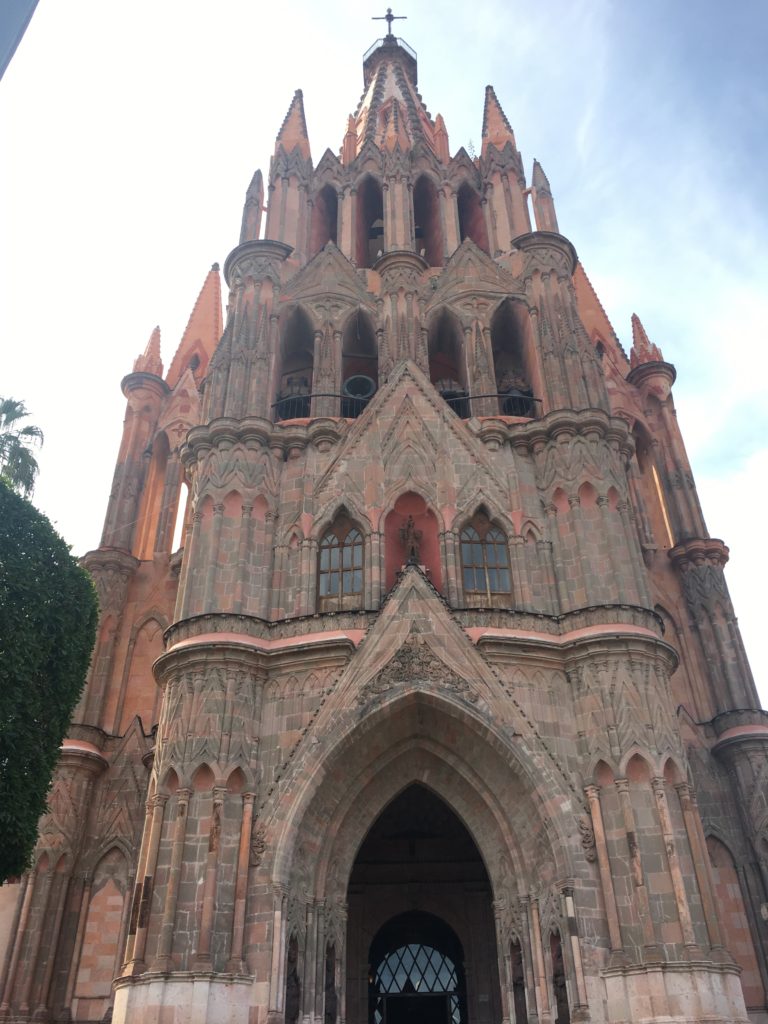

Part II: Experiencing Día de los Muertos
In this section, I’ll give you all the context you need to know to be an educated Day of the Dead tourist.
First, I’ll talk about Día de los Muertos the Mexican tradition: the history, tradition, contemporary celebration, and common symbols.
Then I’ll talk about Día de los Muertos in San Miguel de Allende, so that you can plan your trip and know what to look for when you arrive.
If you want to skip the context, click here to read the Best of Día de los Muertos in San Miguel de Allende.
Día de los Muertos: Context & Culture
History & Tradition
Día de los Muertos (Day of the Dead) is observed annually on November 1st and 2nd. According to tradition, starting on midnight of October 31, the gates of heaven open and the spirits of deceased children can rejoin their families for 24 hours. After midnight on November 1st, the spirits of deceased adults can do the same.
The roots of the holiday go back to Ancient Mesoamerica, where the Aztecs, Maya, and Toltec held a cyclical view of the universe, and saw death as an integral, ever-present part of life.
As Mexican tradition goes, once a year the dead are invited back to celebrate with the living. Family and friends welcome the spirits as honored guests. The reunion is one of joyous remembrance and colorful decoration, usually involving lots of food, drink, music, and storytelling within the intimate community.
On gravesites and ofrendas (altars) set up in homes, businesses, and public areas, families put up photographs and leave an enticing variety of foods, beverages, and other offerings to aid and incentivize the deceased in their journey. Golden cempasuchil (marigold) flowers, with their bright color and heady scent, are thought to help guide the spirits back home. Beautifully hand-painted calaveras and calacas (skulls and skeletons) made of sugar or chocolate represent rebirth into the next stage of life. Candles light up the cemetery. La Catrina (a female skeleton wearing high-society Spanish dress) symbols abound.
Contemporary Celebrations
Up until fairly recently, Día de los Muertos was more of a personal ritual, a time to intimately remember ancestors and deceased family. It took place in homes and cemeteries, in small groups. Calaca (skull) make-up was mostly done as a fun activity in schools. Parades and processions were rare and small in scale.
And then, the James Bond film Spectre was released in 2015. In the film, Daniel Craig, starring as James Bond, uses a big Day of the Dead parade in Mexico City as a boisterous cover while he chases after bad guys.
The funny thing is, Day of the Dead parades did not exist! Not yet, anyway.
In 2016, Mexico City’s local government and Mexican tourism officials decided to embrace this new interpretation of Día de los Muertos. Mexico City held its first Day of the Dead parade to mixed reactions from Mexicans. Some felt this was a commercialized subversion and a distraction from the real meaning of a sincere tradition; others felt that it was an inevitable shift toward spectacle tourism in Mexico.
Successive Bond-style parades have become bigger and more pervasive, with thousands of people in calaca make-up and Catrina dress, and massive works of art showcasing the creative talent and colors of festive Mexican culture.
With all change, there is a period of adjustment. It seems that today, most have gotten accustomed to the parade and some even appreciate it as a different type of family fun. While the parade itself is new, the elements are still quintessentially Mexican, with food carts, lively music, colorful dresses, whoops and hollers.
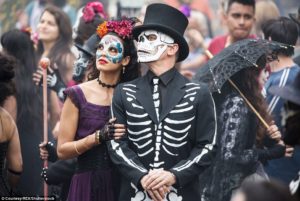

La Catrina: Satire & Symbol
As you can tell, I love context. And I especially love the story of La Catrina, and how she became a symbol of Mexican nationalism and revolution. If La Catrina is accompanied, her male counterpart is El Catrin.
“La Calavera Catrina” was a cartoon first created by Mexican artist José Guadalupe Posada in 1910. In his original work, she is a female skeleton wearing an extravagantly plumed, French-style hat.
In a later portrayal, by famed painter Diego Rivera, La Catrina also wears an equally elegant European-style dress. She stands in contrast with Frida Kahlo, who wears a traditional Mexican dress.
La Calavera Catrina was a political, satirical commentary. It caricatured native Mexican women who sought to appear higher class by dressing like wealthy, high-society European women. His deeper criticism was that these women were willfully scorning their Mexican heritage, deepening the class divide by flaunting their wealth and privilege.
The image proliferated alongside the Mexican revolution, a revolution brought on because of the deep, systematized divide between the poor and the fabulously wealthy.
Political commentary and Día de los Muertos aside, today the true representation of La Catrina is this:
In death, everyone is equal. It does not matter your dress or your wealth in life, we all have the same inevitable end.


Additional “Research”
A fun, visual way to do some “research” before your trip is to watch Coco, the animated Disney Pixar movie. I know what you may be thinking, but many local guides will recommend this movie as a wonderful and entertaining depiction of what this ancient holiday represents. From cenotes (freshwater pools) to elotes asados (grilled corn with toppings) to famous faces like Frida Kahlo and El Santo, so much of Mexican culture can be recognized in this movie.
Día de los Muertos: Celebrated in San Miguel de Allende
When I first started researching Day of the Dead events in San Miguel, most of the Google results were about fancy open-bar rooftop parties, high-priced face-painting-and-photography packages, and a big parade that, according to one blogger, had an abundance of people from Houston, Texas.
What?? San Miguel is often criticized as too gringo, too Disneyland cultivated, but for Día de los Muertos I knew that there had to be something more traditional, more local, more… authentic?
Luckily, I arrived in San Miguel a few days before the holiday. This gave me enough time to dig through what was commercial and touristy, and what was the real thing.
Día de los Muertos: Where to Find the Calendar of Events
In my experience, I found that it was hard to find one source of information that included every event. You may have to check several resources and keep your eyes and ears open.
Posted about a week in advance, I found a complete schedule of Día de los Muertos events at VisitaSanMiguel.com. The list of events is in Spanish, but you can run it through Google Translate. This was my go-to, especially since it had some free community events that a couple of other sources did not. If you can’t find it from the site, try Googling “Día de los Muertos [the year] Calendario.”
Another option is Atención San Miguel, the city’s local newspaper. It’s issued every Friday and includes articles on politics, community, classes, workshops, and more. You can pick up a copy on Friday mornings at the jardín in front of the Parroquía or any time at the Biblioteca Pública (Public Library). You could also check with your accommodations for a free copy. This is a great read for what’s hip and happening in San Miguel. It’s written in Spanish and English, which makes it a great way to brush up on your Spanish.
The calendar insert found inside of Atención is separately named Que Pasa. An online version can be found at QuePasaSanMiguel.com.
You can also check DiscoverSMA.com or visit the tourist information center, in the back of the Allende jardín.
Insider Tip: Take your reading material to enjoy outside, while basking in the sun at the Jardín (Allende Jardín, per Google). Or, look through enough doorways off the main streets of the centro and you’re bound to find a hidden square with a café or seating area. Stumbling upon a quiet, sunny courtyard is one of the best surprises in San Miguel!
Día de los Muertos: Community Events vs. Sponsored Commercial Events
Fortunately, I discovered that San Miguel de Allende has both community events and sponsored commercial events. You can distinguish between them mostly from the price tag.
Community events, sponsored by the local government of San Miguel de Allende, are free or reasonably priced and generally don’t require reservations.
It’s at these events where you are reminded of the original purpose of the holiday, as the whole family gathers to celebrate and honor their deceased. The two days of Día de los Muertos are full of these images of a tight-knit community:
- Children stream out of school and momentarily take over the streets with their painted faces, holding clear bags of calavera candies and pan de Muertos (bread decorated with bones in the shape of a cross) to bring home.
- Groups of teens gather in the days beforehand, and in the morning of, to serve as a human chain, cutting and assembling brightly-colored tissue flowers. These flowers are used as decorations for ofrendas, cemeteries, and doorways.
- Multi-generational families line up to visit the cemetery together. They clean, water, decorate, pray with, and entertain the graves of their deceased. From wheelchairs to strollers, it seems the whole family participates.
- Family and friends gather en-masse to enjoy free evening shows in the plazas, like mariachi bands, dances, concerts, and movies. They make reasonable seating out of almost anything, and keep warm with steaming hot tacos, tamales, gorditas, and cups of stew sold from street carts.
Commercial events, on the other hand, are much costlier to participate and generally have modern partygoer concepts like an open bar, rooftop party, or exclusive packages for the best Instagram selfies. These events are sponsored by upscale hotels, restaurants, and bars, and are geared toward wealthy travelers and partiers, both national and international.
Before I sound like I’m bashing these commercial events, let me clarify:
- There is nothing wrong with businesses putting together a more luxurious and convenient experience for travelers at a higher price point. These events bring in a lot of money to the city, which I hope trickles down to the local community.
- There’s also nothing wrong with being a traveler seeking these kinds of events – they’re fun, “treat yo’ self” approved, and still probably less expensive than a night out in Los Angeles or Las Vegas.
- In my opinion, these events don’t inherently take anything away from the more traditional Día de los Muertos activities. These events may not be part of tradition, but don’t let that stop you from enjoying what the city has chosen to offer to its travelers.
I distinguish between community events and commercial events because I don’t want other travelers to feel like this is all that there is in San Miguel. It might seem like it, especially since these events have stronger marketing efforts, but Día de los Muertos in San Miguel is not based on a VIP list.
Día de los Muertos: Halloween, But Not
No, the Day of the Dead is not like the Mexican version of Halloween. The proximity of dates is a coincidence.
Having said that, a smaller, downplayed version of Halloween has been imported to San Miguel over the years.
In San Miguel, most of the action is in the centro and especially around the jardín and Parroquía. Children get dressed up and collect candy from those who appear to have some. Mostly, these are expats with big baskets and reusable shopping bags brimming with treats. The majority of the children go with the Catrina and Catrin look, with a black-and-white painted face and a fancy dress or handsome suit. At least this part of Halloween in San Miguel feels less imported.
Adults don costumes and go to late-night parties. Some folks get really dressed up and pose for tips. Mariachi bands stake out the different corners of the jardín and, combined with characters dancing on stilts, create much of the fun atmosphere. Around the jardín, sizzling food carts serve up tacos, elotes asado, and burgers for the cold and hungry.
When it comes down to it, Halloween is just an excuse to wander the town for some good ol’ people watching. Dress up is optional, though if you’d like to get your Catrina or Catrin make-up, Halloween is a good day to do it.
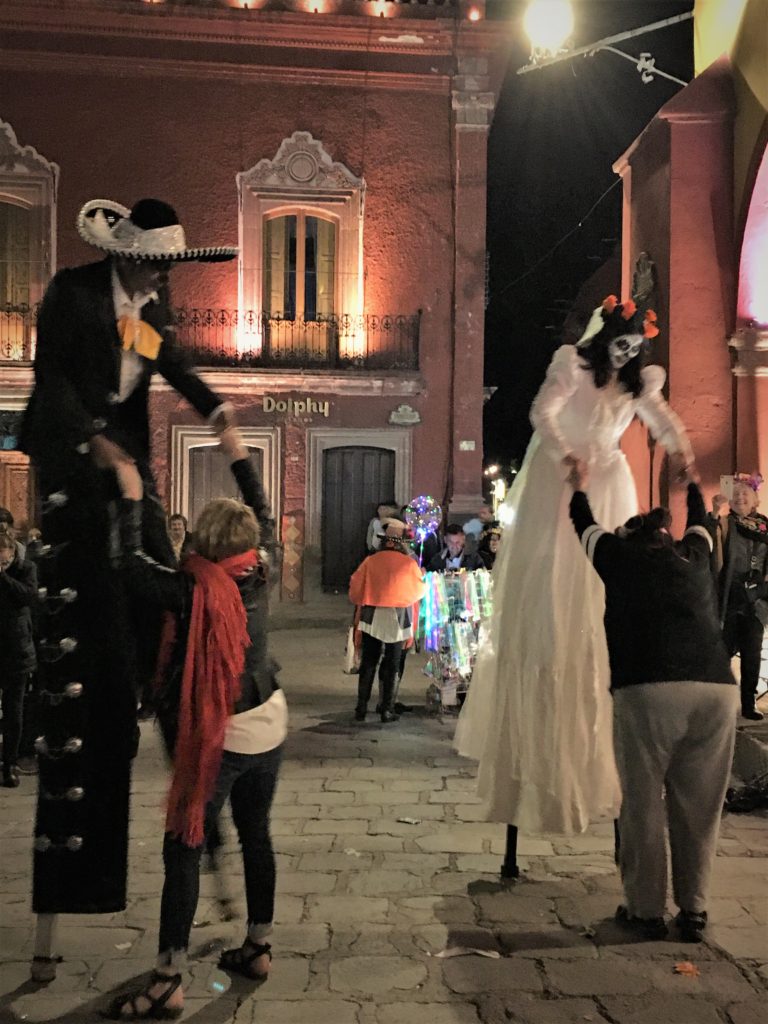

The Best of Día de los Muertos in San Miguel de Allende
Now that I’ve given you context about Día de los Muertos in San Miguel, here is my list of You-Can’t-Miss-It activities, roughly in order of when they occur.
Over the three days of October 31, November 1, and November 2, San Miguel gradually comes to life with more and more decorations, altars, and art pieces.
Said another way, you can visit something on the 31st, but it may not be completed until the 2nd, regardless of what it says on the calendar. Or, you can be the only two people waiting for an event that was advertised – and apparently canceled – like Jon and I were.
Sometimes, that’s just the way things are in Mexico.
Halloween
Join the crowds and wander the centro on Halloween night. Bring candy to hand out, if you wish. The most poppin’ place is around the jardín. Finish the night with a couple treats for yourself, in the form of made-to-order tacos. It’s always amusing to see monsters, skeletons, and princesses dining together.
San Miguel’s Panteónes (Cemeteries)
For 2019, there were two cemeteries included in the Day of the Dead special events listing: Panteón de San Juan de Dios, and Panteón de Nuestra Señora de Guadalupe.
I suspect that the small Panteón de San Juan de Dios was only listed because the neighborhood of San Juan de Dios was selected to host 2019’s Day of the Dead events. Several other community cemeteries around San Miguel were open for family and friends to set up ofrendas. At San Juan de Dios, it was quiet during the day and there were long lines in the evening.
The Panteón de Nuestra Señora de Guadalupe, on the other hand, is the main cemetery. There is a fast-moving line to enter and exit the cemetery. People bustle about carrying water, cleaning graves, decorating with flowers, candles, and photographs. Some families pray quietly, while others have a microphone with stereo. Wandering bands play music and sing songs; groups gather to joyfully banter, or solemnly hug. One traditional line of thinking is that the louder you are, the better the spirits can hear you. This applies to laughter, song, and fireworks – at all times of the day.
Though you’ll find tourists and even tour groups at the cemetery, the environment should remain one of respect and privacy. Any photographs should be very discrete. Leave the painted faces, loud voices, and revealing clothing for a different time and place.
Bring tissues, for yourself or others. Día de los Muertos tradition asserts that sorrow and grief will offend their deceased ancestors, and thus the living should maintain a joyous, celebratory energy. But, in the end, a cemetery on Día de los Muertos is still a cemetery.


Día de los Muertos Ofrendas (Altars)
Ofrendas are set up everywhere, large and small. In addition to the specific neighborhood listed on the calendar, you’ll find ofrendas in plazas, courtyards, businesses, and markets. Some ofrendas will have a bowl for donations, especially if you take photos.
Ofrendas can offer quite a display of food and artistry. The pictures below show huitlacoche (corn smut), prickly pear fruits, bananas, beans, chayote squash, mole, salsa in a molcajete, chicharrones, cheese, tamales, pan de muerto, chicken feet, and a whole lot more. Images are painstakingly made of dried peas, beans, rice and seeds. There are flowers and flower petals, photographs, messages, and trinkets.


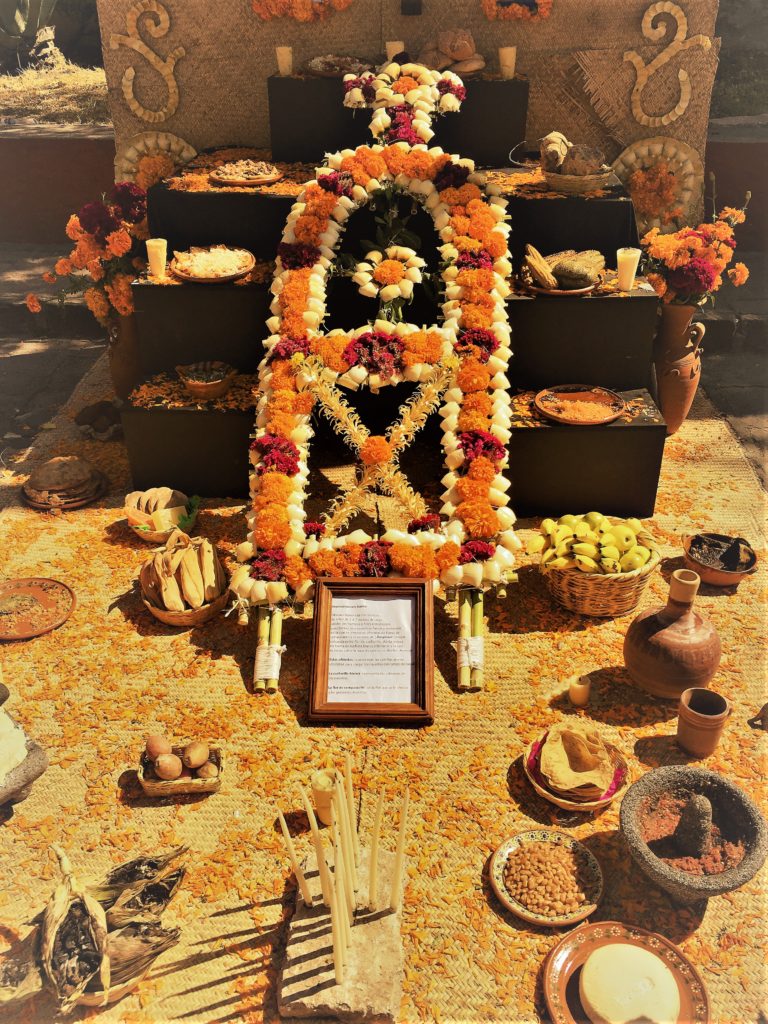

The Parroquía de San Miguel Arcángel and its Crypt
The iconic Parroquía is the most famous symbol of San Miguel. San Miguel’s reputation as “Disneylandia” is made all the more so because of this Cinderella-like Parish church that dominates the town’s skyline.
Once a year, during Día de los Muertos, the Parroquía welcomes visitors into its underground crypt. The crypt dates back to around 1830, and it houses hundreds of former priests and citizens of San Miguel. The most famous resident is Anastasio Bustamante, a former President of Mexico.
During our visit in 2019, the Parroquía was closed on the days leading up to November 1 & 2. I’d heard this was to encourage more visitors for the actual holiday.
Entrance is free, though there is a donation box at the front.


La Catrina Parade
The first La Catrina parade was held in 2002, with only eight participants. It was created in response to the growing influence of Halloween, which threatened to overtake the representations of Día de los Muertos.
Today, the parade is popular, with hundreds of people participating in the short, very slow, walk through town. The parade usually starts at the upscale Rosewood Hotel and ends at whatever community has been selected for the year.
While the La Catrina Parade offers a full menu of pay-per-service options (like a cocktail party, professional make-up and photography, and several dinners and open bars), the parade itself is free to attend.
Its accessibility to all makes it a very popular and lively community event. They encourage you to dress up, and many do, so this is a great time to participate in the La Catrina and El Catrin make-up.
Día de los Muertos Performances & Concerts
Whatever you do, do not miss the finale presentation put on by the city of San Miguel!
It may be different in the coming years, but here’s a taste of what happened for 2019:
In 2019, there were free evening performances of music and dance for both November 1st and 2nd.
For the evening of the 1st, it was difficult to decipher one event from another, though it’s possible I just wasn’t in the right place at the right time. We were wandering as part of the La Catrina Parade, and there was lots of festive activity in general. Whether it was the calendared event, I’m not sure.
On the evening of the 2nd was the big finale! This event, or series of performances, I highly, highly recommend.
For the finale, there was a huge stage built and hundreds of chairs set out in the Plaza de los Insurgentes. After the seats were filled, crowds stood on planters, benches, and even on the backs of trucks to get a view of the stage.
The main event was a performance by Luis Ángel Jaramillo, the voice of the character “Miguel” in Disney Pixar’s Coco. He was accompanied by the incredibly impressive SoundTraffic Orchestra. Together, they performed renditions of songs from the movie Coco, like “Remember Me” and “Un Poco Loco,” much to the dancing glee of many children (okay, and myself).
Additionally, there was a ballet accompanied by mariachi, and a performance of several songs from the Phantom of the Opera. The orchestra and operatic singers delivered incredibly impressive, powerful performances! Bravo!


Día de los Muertos Disclaimer
Based on my research, I do believe that the city of San Miguel is still experimenting with what it wants to offer for Día de los Muertos.
The information I’ve given above could very well change in the coming years, as ideas get tweaked and logistics improve.
But I do think the City of San Miguel is on the right track. Comparing 2018 to 2019, it seems like the city has taken greater ownership of its Día de los Muertos events. The local government has created their own impressive program, instead of promoting and relying upon a series of disconnected offerings from third parties. The move toward cohesive community events is a great improvement!
The Best of San Miguel de Allende
After the ofrendas and decorations get taken down, and the big crowds disperse, San Miguel goes back to its life as a small, relaxed city up in the hills of Central Mexico.
Explore the Artistic Side of San Miguel
What better way to appreciate the quiet after a holiday exodus than to explore the artistic works that make San Miguel so famous as an artist’s haven?
Here’s where you can find art and artists in San Miguel:
- Wandering the streets of colonia Guadalupe. Street art murals abound. Cost: free.
- Visit the Mercado de Artesanías (Artisan’s Market) for handmade crafts and artworks for sale. Cost: free to enter.
- Wander Fabrica la Aurora, an old textile factory that today houses canvases, sculptures, and artisan products of great artists who live in San Miguel. Cost: free to enter.
- Visit the Centro Cultural Ignacio Ramírez (Cultural Center), also called the Escuela de Bellas Artes (School of Fine Arts), for its art exhibits. Cost: free.
- Wander the streets of colonias San Antonio, Guadalupe, and Zona Centro, and you’ll encounter several art galleries. There are always new ones opening up. Cost: usually free.
Views in San Miguel
A city so renowned for its colonial architecture must also have some excellent viewpoints, right?
Here are the best spots to enjoy a look at San Miguel from above:
- El Mirador is a good hike to a fantastic view of the city. There are telescopes and a few vendors. Cost: free.
- The Luna Rooftop Tapas Bar is a part of the upscale Rosewood Hotel. The view is stunning, especially around sunset. Their website says it all: “Rich shades of terracotta, ochre, earthy browns and dusty pinks contrast perfectly with a vivid blue sky, then are transformed by magnificent sunsets. Throughout the day and night, this al fresco setting presents breathtaking views of the iconic La Parroquia, spires, bell towers and rooftops across town.” Cost: U.S. prices, though perhaps not if you consider the elegance of the venue.
- La Atozea (meaning “the rooftop”) is a lovely rooftop bar & restaurant just steps from the jardín, making it the most central place to nurse a drink while you watch the sunset. Though we didn’t partake, we heard they have the best fish tacos. From the street, you have to enter through the doors of the Pueblo Viejo restaurant. On the right is a staircase that leads to the rooftop. Come early if you have any desire to get a seat. Cost: quite reasonable for the area.


Eat & Drink in San Miguel
With the influx of expats and tourists, San Miguel’s restaurant scene has flourished over the years, offering a variety of Mexican, American, Italian, French, and even Thai eateries. The availability of vegetarian, organic, gluten-free, and all sorts of dietary preferences is impressive, considering San Miguel’s size and relative remoteness.
A Disclaimer, Before the Recommendations
We’d heard, probably as you have, that San Miguel has a great restaurant scene. So, we were curious.
After trying several places, over perspective is that the ambiance and the service are superb. If you drink and dine at popular times of the day, the restaurants are fun, lively, and a great way to spend time “out” in San Miguel. The staff are wonderfully courteous and most can help you in English.
As for the food, we felt most of the restaurant fare is still a bit generic, likely the result of catering to so many foreign visitors. Our preference, instead, is to fill our stomachs with a variety of delicious street and market meals for a great price. That’s why you won’t find very many sit-down restaurants in our suggestions.
And so, I present to you our shortlist of recommendations from everything we tried, in the following categories:
- Food – street food, markets, and restaurants
- Pastries – our go-to treat in the early afternoons.
- Craft Draft Beer – the elusive treat that it is in Mexico.
Street Tacos for Dinner in the Centro
Street taco carts come out at night only, usually from sundown to late, late night. They will always have corn tacos with the traditional trifecta of pastor (pork), bistek (steak), and chorizo (sausage). Most times, they will also have lengua (cow tongue) and cabeza (cow head). Most places have gringas too. Gringas are tacos with a large flour tortilla, filled with cheese, your choice of meat, and pineapple, and then grilled like a quesadilla. Vegetarians can order quesadillas. Lastly, when they hand you your plate, ask for “cebolla” (grilled onion) if they didn’t already give you one. The bulbs are grilled whole, and they’re delicious.
There are at least three taco carts within a three-block radius south of the jardín (Andy’s Taco Cart is marked on the GoogleMap; the other carts seem to roam in location). They serve up food from around 7 pm to 5 am, nightly. If it’s busy, find the person taking orders. If it’s not busy, stand at the table and make eye contact with the cook. Place your order, listen for your name, enjoy your food, and then pay. I usually watch other customers for who they pay, where they put their used plate, etc.
Tacos “Santos” seems to be the taxi driver’s favorite of the centro. It’s located in the San Antonio neighborhood. Being a little off the tourist track, you enjoy larger, more filling tacos for a lower price. You also get to be a tourist in a busy hangout for locals.
If you cannot eat spicy, let the cook know first (“No picante por favor”) and ask about the salsas before trying them. Just point and ask, “Picante?” If the answer is affirmative, don’t try it. If the answer is “un poco” (a little), proceed carefully. Mexicans often understate the level of spiciness.
Insider Tip: When ordering in a busy crowd, use a distinctive name. Jon as “Juan” is just too commonplace. He uses the name “Tortuga” (turtle).


Day-time Market Meals
Most markets in San Miguel have a food section and a shopping section. They go hand in hand like lime and chili.
Tianguis Martes (The Tuesday Market) is my favorite market in San Miguel. The market is massive and includes everything: groceries, prepared foods, clothing, shoes, tools, kitchenware, furniture, and even pet birds.
The prepared food section has a huge variety of offerings, all at great prices. There are roasted, grilled, and fried meats sold by the quarter kilo. There are stands selling tacos, gorditas, tortas, and sopes. There are handmade tortillas, cheeses, toasted nuts, and candied sweet potatoes.
While grocery shopping, Jon and I walked by a hot, bubbling vat of oil, from which were retrieved several pieces of freshly fried, battered tilapia. Of course, we couldn’t resist. We were served a big filet fresh out of the fryer, on a bed of raw cabbage on a corn tortilla, with some lime wedges. Fantastic, and only MXN 35, or $1.55 USD!
This market is quite a bit east of the city – you can take an Uber, taxi, or public transportation.
Mercado SANO (and the Organic Market held only on Saturdays) are also great options if you want organic groceries and artisanal foods. The Saturday Market is set up outside, behind Mercado SANO. This spot is very expat- and tourist-friendly. The prices are a bit higher than a traditional market, but if buzzwords like organic, gluten-free, local, and artisan appeal to you, then this is the place to go. It’s located at Ancha de San Antonio 123.


Insider Tip: Bring several reusable bags to carry your purchases. We even bring Tupperware sometimes. And, as with many crowded places, take precautions so you are not pickpocketed. That means keeping your valuables tucked away securely, not willy-nilly in an outer pocket. Yes, even your phone.
Pastries at the Panadería
A panadería sells bread-based goods (not to be confused with a pastelería that sells cake-based goods). Panaderías sell plain bread rolls, pan dulces (sweetbreads), empanadas (stuffed turnovers, either sweet or savory), and galletas (cookies). These categories can be further broken down into a hundred different pastries with specific names.
To keep things simple, I find there are two major distinctions: sweet vs. savory and bready vs. flaky. I recommend a combination of the four axes to diversify your feast.
La Colmena Panadería is the oldest bakery in town, opened back in 1901. The flaky pastries are my favorite here, although I find their bready pastries are also lighter than at other places. ~ MXN 10 per pastry.
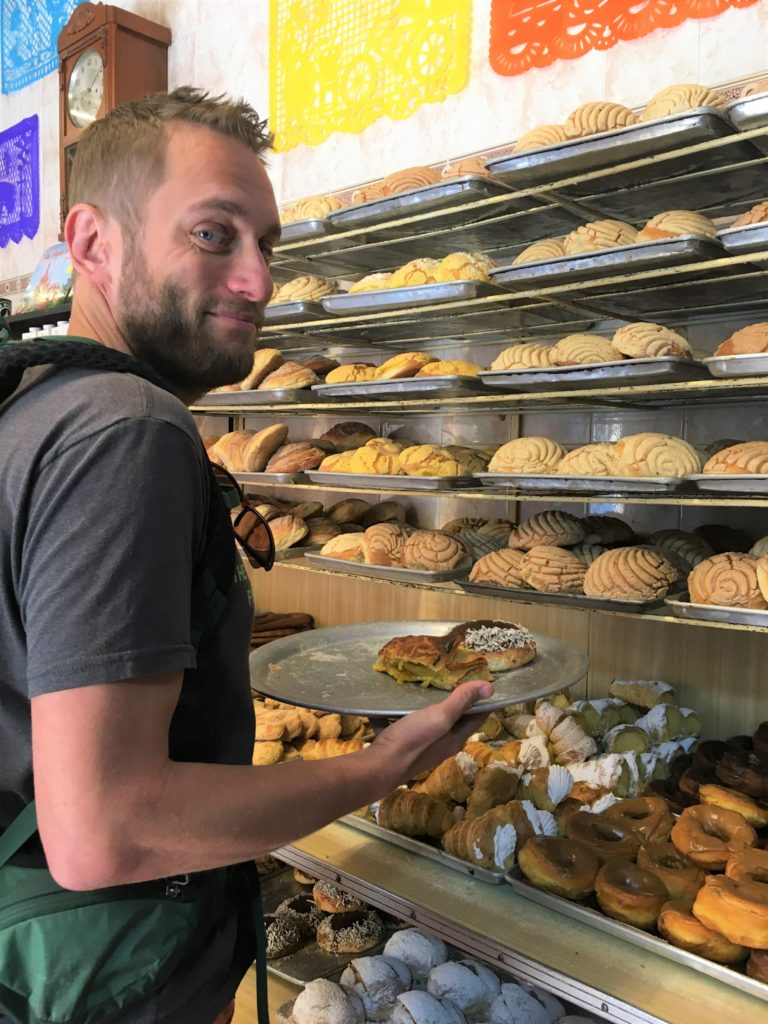

Del Bueno Panadería has a huge selection of beautiful, mouth-watering pastries. I find their breads yeastier and chewier than others. Their flaky, fruit-filled pastry was delicious – not too sweet and very crunchy. ~ MXN 7 per pastry.
Panadería Miga Artesenal is both a sit-down café and a serve-yourself bakery. I would describe their pastries as more French – lighter, flakier and very fresh. While they are the most expensive, at MXN 20 per pastry, they are worth it. We got the cinnamon bun and the almond croissant. Both were the best we’d found after a month traveling through Mexico.
Craft Draft Beer
We’d been in Mexico for almost a month before heading to San Miguel. Our craft beer supply from the U.S. had run out. Jon, ever the beer geek, was determined to find artisan craft beer on draft in San Miguel.
In Mexico, draft beer is de barril. Craft beer is cerveza artesenal. While it’s reasonably easy to find one or the other (either standard beer on draft or bottled craft beer), finding a place with cerveza artesenal de barril is quite difficult.
But, after ducking our heads into several places, we prevailed!
We found two spots in San Miguel de Allende:
- Mamma Mia, just a block from the jardín, has a wonderful selection of draft beer. I don’t know if it rotates, but on our visit, they had three La Hechicera beers: an IPA, a Pale Ale, and a Porter. The Pale Ale was our favorite. We enjoyed the beers over two pasta dishes and live jazz. If you like them, you can also bring them home in a growler.
- Cervecería Dos Aves is San Miguel’s only craft beer tasting room. It’s a bit out of the centro. We walked, but I think that most people wouldn’t.
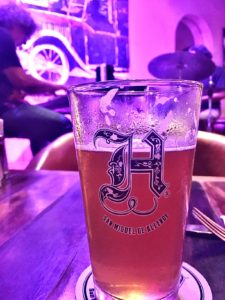

Buen viaje a San Miguel de Allende!
If you have any questions or comments, feel free to contact us at hello@DangGoodLife.com.
If this article has helped you to plan your own adventure in San Miguel de Allende, please consider supporting us by shopping through our affiliate links, sharing this post, and engaging with us on our social media channels. Your support helps us keep gas in the van so that we can continue to provide this Dang Good content.
With sincere gratitude,
Lien & Jon
